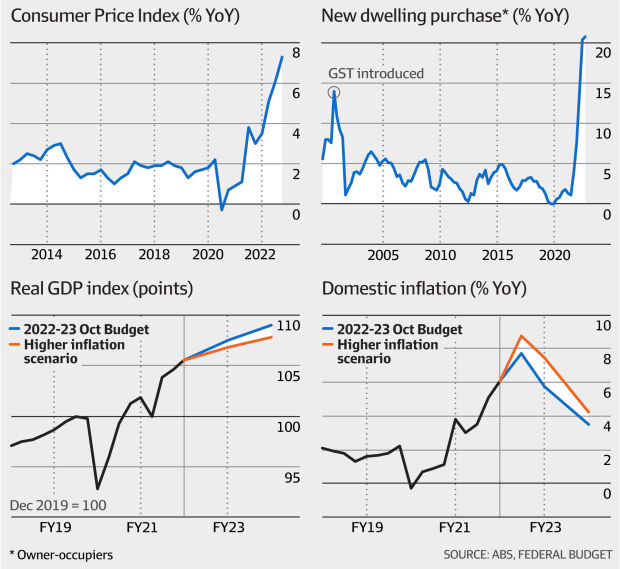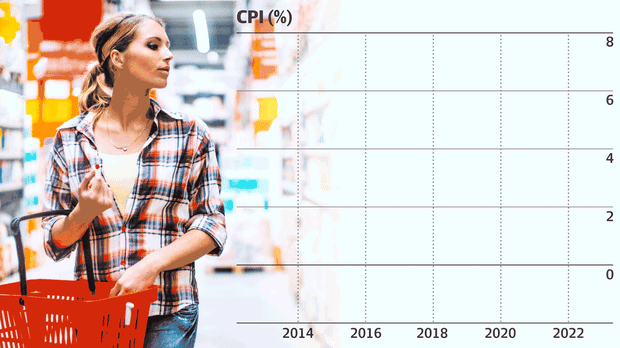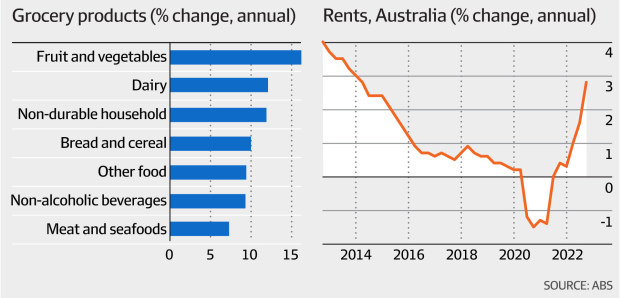National Australia Bank upgraded its forecast peak in the cash rate from 3.1 per cent to 3.6 per cent while ANZ and the Commonwealth Bank both added 0.25 percentage points to 3.85 per cent and 3.1 per cent respectively.
HSBC Australian chief economist Paul Bloxham sounded a note of caution, suggesting the inflation challenge needed to be balanced against a weakening global backdrop and still only modest local wages growth.
At 3.85 per cent, monthly repayments on a 25-year, $500,000 mortgage will have increased by $1058 since May, $1587 for a $750,000 mortgage, and $2117 for a $1 million loan, according to comparison website RateCity.

Treasurer Jim Chalmers labelled inflation “public enemy No.1” in his post-budget speech at the National Press Club.
“Inflation is the dragon we need to slay,” he said, referencing The Australian Financial Review’s page one illustration by David Rowe yesterday. “It’s the source of most concern in our communities.”
Dr Chalmers said Wednesday’s result didn’t substantially alter Treasury’s outlook and inflation was still expected to peak “around the same levels” towards the end of the year, though there were growing risks.
ANZ’s outlook for a peak cash rate of 3.85 per cent and financial market bets of 4.1 per cent are well above the 3.35 per cent assumption used to underpin the economic assumptions in Tuesday’s budget, suggesting employment levels and economic growth could be squeezed further than expected.
In a higher inflation scenario outlined in the budget, if annual price rises peak 1 percentage point above the current forecast at 8.75 per cent, the hit to the economy would be severe and potentially spark a recession.
“Under this scenario more persistent inflation is assumed to lead to a higher peak in interest rates than currently expected. Higher inflation and interest rates would lower real household disposable income,” the budget said.

Consumer Price Index changes. AFR
This would lop about 0.25 percentage points off growth in 2022-23, and halve growth the following year from 1.5 per cent to just 0.75 per cent.
A further 100,000 people would join the dole queue by June 2024, taking the total to about 250,000, pushing the unemployment rate from the current near-50-year low 3.5 per cent to 5.25 per cent.
“The worst thing that could happen to people who are at risk of being left behind in this country, is if we let inflation get out of control,” Dr Chalmers said. “Inflation inflicts a hammer blow on Australians.”
Illustrating the point, non-discretionary inflation – price rises on the goods and services households can’t cut from their budgets – rose 2 per cent over the quarter to be 8.4 per cent higher through the year.

“What we saw in the inflation number today was unfortunately the front end of some of these pressures on electricity prices,” Dr Chalmers said. “A bigger and bigger part of our inflation challenge will be a combination of higher electricity prices and the impacts of natural disasters on grocery prices.”
Electricity prices rose 3.2 per cent between July and September, lower than the 20 per cent forecast in budget, which was due to state government subsidies in Western Australia and Queensland, according to the ABS.
“Excluding the effect of these schemes, electricity would have risen 15.6 per cent in the quarter,” ABS program manager Michelle Marquardt said, with the remainder of the increase due in the final three months of the year.
The budget forecast power bills were set to rise 20 per cent over the second half of 2022 and a further 30 per cent in 2023-24, for a total of 56 per cent.
Headline inflation over the September quarter was largely driven by the cost of housing construction (up 3.7 per cent), gas prices (up 10.9 per cent), and furniture costs (up 6.6 per cent).
Annual gas price reviews across the states and territories caused higher wholesale gas prices that were passed on to consumers in the September quarter. Overall gas prices are up 10.9 per cent.
A fall in petrol prices – the first in two years – sparked a small fall in transport costs; however, these are still up 10 per cent through the year.
Dr Chalmers laid the blame for the pain squarely at the feet of Russian president Vladimir Putin and his illegal invasion of Ukraine, which has driven global energy prices to record levels since February.
“War in Europe has played havoc on energy markets,” he said, which was adding to inflation and would be felt “most acutely at the kitchen table”.
The Treasurer flagged an aggressive regulatory crackdown in the energy markets to address the growing hit to household budgets.
Strong increases in grocery prices were recorded across the board during the quarter. Fruit and vegetable prices rose 4.5 per cent to be 16.2 per cent higher through the year, while dairy rose 6.8 per cent to be up 12 per cent.
Recent flooding across the eastern seaboard will increase fresh fruit and vegetable prices by about 8 per cent over the next six months.
https://news.google.com/__i/rss/rd/articles/CBMiY2h0dHBzOi8vd3d3LmFmci5jb20vcG9saWN5L2Vjb25vbXkvYW5udWFsLWluZmxhdGlvbi1oaXRzLTctM3BjLWV4Y2VlZHMtZXhwZWN0YXRpb25zLTIwMjIxMDI2LXA1YnN4dNIBAA?oc=5
2022-10-26 03:49:00Z
1620757189
Bagikan Berita Ini














0 Response to "Australia's annual inflation hits 7.3pc, exceeds expectations - The Australian Financial Review"
Post a Comment